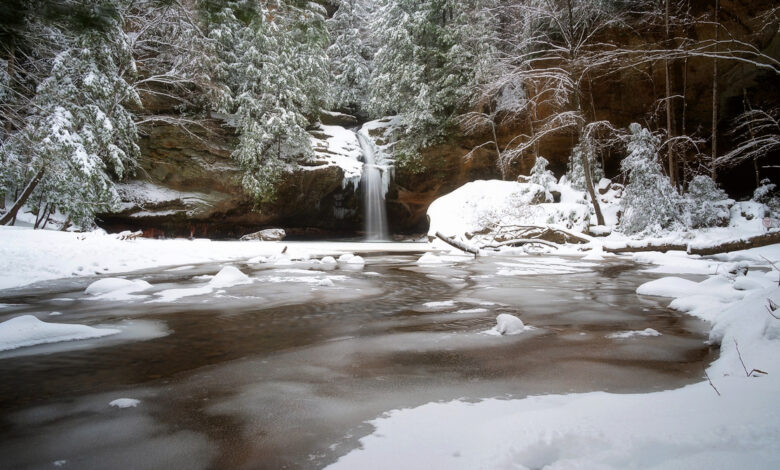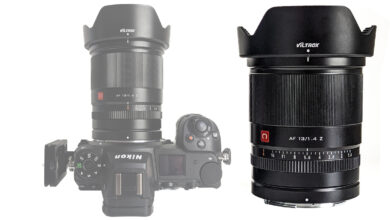Staying Warm for Landscape Photography in the Winter

Cold weather landscape photography is one of my favorite times to be out photographing. Familiar landscapes become unfamiliar once again. But you must be prepared and comfortable while out in the elements. Here is my approach to staying warm in the winter.
I enjoy photographing landscape scenes in the cold weather of winter. You have a chance of seeing familiar scenes covered in snow or ice. Waterfalls, lakes, and ponds freeze, affording new and unique composition opportunities. You can show scenes most people don’t get to see with your wintertime images.
And my favorite thing about landscape photography in the winter? Fewer people! I can visit areas often busy with tourists in the spring, summer, and fall and have places nearly to myself!
But you have to be prepared for the winter weather. If you are cold and miserable, your work will suffer. But with some preparation, it isn’t hard to prepare yourself properly for cold weather and enjoy the wintertime landscape photography experience.

Importance of Layers
Keeping yourself comfortable is the most important. If you aren’t comfortable photographing in the cold, the experience will not be any fun. Everyone tolerates the cold differently, but the layering approach works in some variation for everyone.
Another significant advantage of using layers as a photographer is due to the mix of activities in one trip. During the hiking portion of a trip, we often generate more heat due to the activity, and then once we reach our destination, we stand for long periods of time with less activity, making us cold.
With layers, you can quickly shed an outer shell while hiking to avoid becoming overheated and then once you stop, add the shell back on to stay warm. The ability to add and remove layers as the temperature or your activity level change contribute greatly to comfort.
There are three layers to utilize when out in the cold.
Base Layer
The base layer is the layer closest to your skin, typically long underwear of some sort. This is an integral part of the layering system, as it helps keep moisture away from your skin, making you feel warmer.
Something like this Duofold Thermal Shirt is a good example of a possible base layer option. I use both upper and lower body base layers as soon as the temperature drops on my outings.
Middle Layer
The middle layer is an insulating layer that helps keep the warm air near your body and the cold out. There are many options for your middle layers, from fleece vests, to fleece jackets, to down vests, and jackets. There are even legging options in various materials as well.
These middle layers are where you can tailor your layering system to your own comfort in the cold. Some people might want a fleece vest, a fleece jacket, and a down puffer jacket to stay warm. Others might shed one of those layers to stay a little cooler.
Outer Layer
The last layer in the system is the outer layer. Those middle layers, while excelling at insulation, aren’t always the greatest at wind protection or keeping you dry from cold rain or snow.
An outer shell layer will have varying levels of waterproofing or water-resistance while also protecting from the wind. When these shells are coupled with the other two layers, they provide a very comprehensive and flexible system to keep you warm and dry while you practice landscape photography in inclement weather.

A Hat: Keep the Head Warm
Don’t underestimate the importance of a warm hat for your head. You can lose a lot of heat through an uncovered head, which causes your body to be inefficient in trying to keep the rest of it warm.
A warm hat similar to this Columbia beanie is one of the first clothing items I don for cold-weather outings. If I can keep my head warm, I can stay much more comfortable when out photographing in the winter. Don’t forget the hat!
Gloves
Gloves are another essential item of clothing, though somewhat tricky for photographers. We need to keep our hands warm, but we also need to maintain the dexterity of our fingers so we can change camera settings, use the shutter button, and adjust our zoom lenses.
Different photographers will have different opinions, and it can take some experimentation to see what is most comfortable for your use. After lots of time in the field, I have two sets of gloves I use most often.
In 30 °F weather and above, I use a set of fingerless gloves. They keep the core of my hand warm but keep my fingers free to use the camera efficiently. In weather under 30 °F, I use mittens with flip tops that are insulated and have a shell for wind protection. Those have worked well for me down to sub-zero temperatures and high winds.
Some photographers prefer a two glove approach with a thinner liner and a heavier outer shell to slip on over the liner in really cold conditions.

Protect the Feet
Your feet can be subject to a lot of abuse in cold weather landscape photography. From trudging through snow to standing on cold rocks or frozen lakes, it is important to be mindful of your feet.
I wear hiking boots for nearly all of my hiking, but wearing a sturdier and warmer boot is important. The socks you wear are important as well, they need to have insulation properties and wick moisture away from your skin.
If you know you are going to encounter deeper snow, a set of gaiters to keep the snow from getting into your boot from the top is essential. I often toss a pair into my backpack if uncertain of the conditions I might face.
While not so much related to keeping warm, be mindful of the conditions. If you know you will be on icy trails or crossing frozen lakes, invest in a set of microspikes for your boots. These traction control devices easily fit over normal boots and make you much more sure-footed as you are hiking or standing on frozen lakes taking photos.
Enjoy the Winter
Landscape photography in the winter can be a gratifying experience. Winter photography is a great time, from enjoying locations with fewer people to capturing scenes many will never see. Many shy away from the experience because of the cold, but with preparation and a clothing plan, you can stay comfortable on the hike and while photographing in some fantastic locations.
How about you? Do you enjoy wintertime landscape photography? Do you have a favorite tip to stay comfortable in those conditions?




